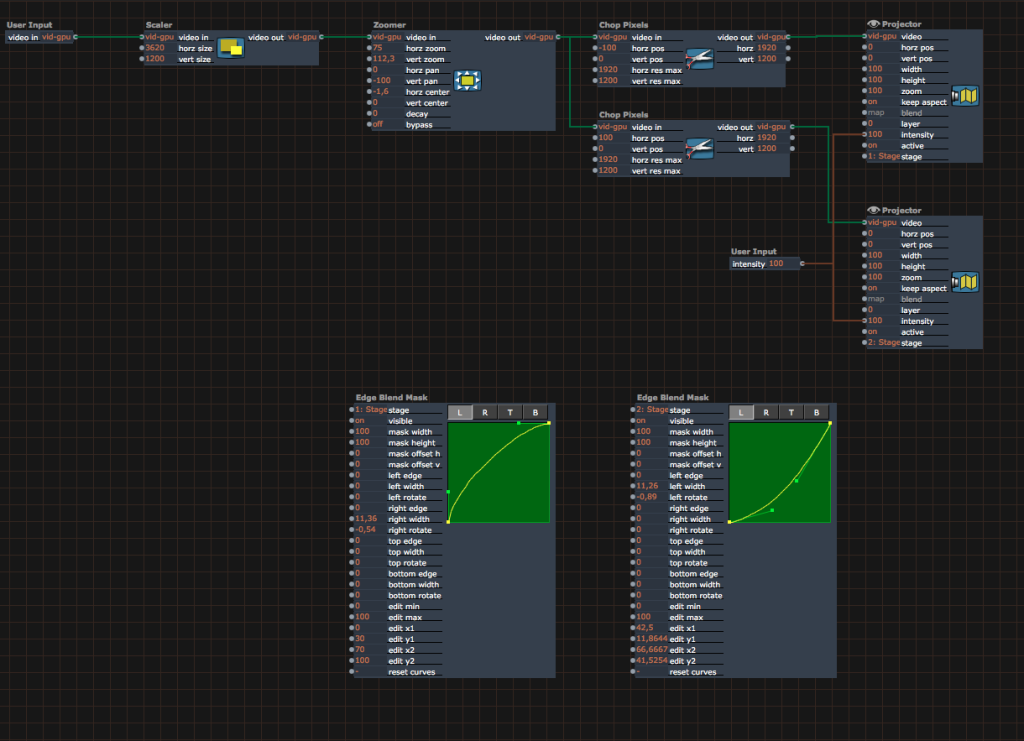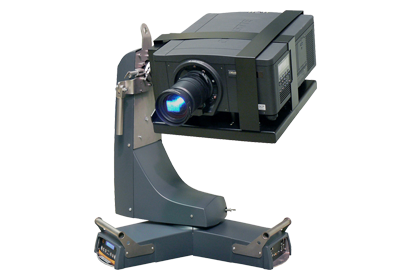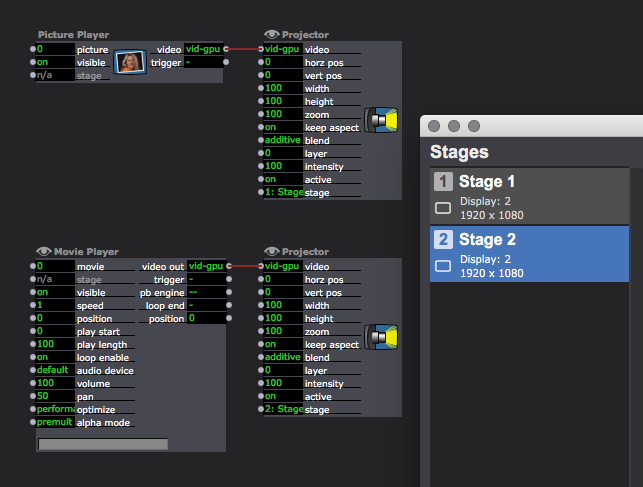Multiple Geometry Using the same display
-
Good to know I'm not the only one.
I feel like there should be some kind of a workaround using virtual displays.
Thanks Dill
-
Virtual Stage came to my mind as well, but it doesn't work, because you can't switch the edge blend actors to blend the middle of the virtual stage.
edit: I wrapped my mind around this and came to the conclusion, it would not work anyway, as one would need to split the stage to the outputs afterwards anyway, destroying the edge blend of the virtual stage.
I ended up using this classical setup:
-
I think at this point using the Edge Blend Mask actors, and doing this outside of the Stage Setups blend features is the only way to 'switch' edge blend settings live.
-
@dillthekraut and @britt you can't get everything for free! Just use 2 extra outputs from your computer to secondary inputs on the beamers (or use a matrix that has good edid close to your computer for less cabling). Setup the two settings as two different outputs and switch inputs on beamers or matrix when you change the lens shift.
Ps how does the lens shift get in exactly the right place in the show, I never saw a beamer that had perfect recall.
-
@dillthekraut said:
I do use two Epson projectors, which are capable of moving the lens shift and focus between different presets in a Show. In one scene, they project on separate screens each a different picture. I
OMG that's crazy! Hahaha... you all amaze me sometimes with the inventive ways you use your tools. Bravo for making my jaw drop.

That said, I can see what you both are talking asking for here now, and why. It's just not something that myself, anyone on the team, nor any of the designers we consulted with every thought of or brought up. I will have to think about what this mean.
I can imagine a way of doing this, where you could define multiple stages that use the same displays, and then a "Activate/Deactive Stage" actor to activate one or the other. So in Scene A, you'd activate "Stage 1" and deactivate "Stage 2", giving the geometry for Stage 1. Then later, in Scene B you'd deactivate "Stage 1" and activate "Stage 2", giving the geometry for Stage 2 instead. The reason you'd need to deactivate it is to prevent Stage 1 and Stage 2 from both attempting to draw to the same stage, leading to a conflict.
I would want to make the user check a box that says "Advanced Mode - Disable Stage Conflicts" or something like this because, for many users, those warnings are important and useful (especially if you're using splitting an output, i.e., using a Data Path or TripleHead2Go.)
I want to discuss this with the team, because when considering a new feature, they often they will come up with a list of issues I hadn't considered. But keep on us about this as we get past the macOS Catalina release and are into October, and we'll see what we can do.
Best Wishes,
Mark -
 We once even went further and mounted a 20k Panasonic Projektor to a moving head base, pointing it to up to 5 different positions in one show! The Lens presets work pretty well and are very tight.
We once even went further and mounted a 20k Panasonic Projektor to a moving head base, pointing it to up to 5 different positions in one show! The Lens presets work pretty well and are very tight.But yes, the 'Activate/Deactive Stage' actor, was in my mind too. Or maybe you could do it automatically with choosing it in the projector actors, but only activate the last chosen one, to be sure to avoid conflicts. But I guess it would be difficult to automatically decide whether a stage is involved and switched off or not.
I'm aware, this isn't a usual setup, but I have the feeling, this feature would have some other potentials, we don't see yet.
The matrix idea is a good one! But this has limits as it would need more outputs at your machine. If you already use 3 out of 4 from your GPU, where to get the others from? I know the datapath and tripple head options, but every extra device is a time consuming and risky extra. I use matrices often anyway for a second backup machine, which would as well push the needed inputs.
But anyway a good approach! -
@fred said:
Ps how does the lens shift get in exactly the right place in the show, I never saw a beamer that had perfect recall.
I do have very good experiences with the bigger Panasonic Projektors (PT-DZxx / RZxx) and the Epson EB-L1505U. I set up a long term Show with the Epson EB doing a relatively complex mapping of different levels and depth without bigger issues. It ran for month now already. But it is the first Time I use these Projectors doing a soft edge blend. They tend to shift over the days a little bit (maybe 1 or 2 Pixel), but as the projection surface moves anyway, I can't for sure tell which is giving this. But after a little correction at the show presets it works very well. And with some (relatively speaking - small) Text, I do have some matching critical content to put on that surface!
-
Hi,
We are looking at a project in June 2020 in a large round ex WW2 storage tank 1023 sq mtr. Have been thinking about a moveable yoke projection. The solution for dynamic edge blending discussed in this thread could be very useful for that project. We are seeing these moving head projectors around - used for public art installations and other projects. @DillTheKraut, I had not thought to use the lens shift of a projector like that, and I am not sure that I would subject the lens shift motors to that much repetitive work, do you think there is any issue with motor strain doing that? I have found the lens shift on the Epson pro's impressive - depending on which lens is fitted. The moving yoke projector is something I am very keen to play with.

Best Wishes
Russell
-
Around 2009, having just completed an Isadora course with @mark, excited by the possibilities I bought 2 Apollo Right arms for use with projectors: https://www.apollodesign.net/right-arm-1396.
I've been using them ever since!
Cheers,
Hugh
-
@citizenjoe said:
I've been using them ever since!
Did you have to fabricate the suspension system for the projectors with these units? They don't appear to be easily available outside US.
best wishes
Russell
-
I don't really have any long term experiences about the mechanical strain yet. I maybe can tell end of next month when we move the long term project from one location to another. But there is one Epson only doing two lens movements the day. As this show is one clone of two others in different countries and build by the same agency, they already have at least no bad experience with it.
On the other hand given the use of rental Projectors, where the lens motors are used a lot over there life span, I doubt this being a factor to worry about. In the end it propably will depend on the count of movements it will do in a given time.
Anyway, the Epson projectors and the newer RZ Panasonics give the possibility to save up to 10 presets, which really isn't a little. But about the possible strain in an installation where there are many movements a day, probably only the manufacturer is capable to tell.
-
@bonemap said:
Did you have to fabricate the suspension system for the projectors with these units?
I always build something for support. It's simpler than trying to adapt somebody else's idea.
Cheers,
Hugh
-
I have used these before:
http://polestar-productions.uk/projectionmapping/dynamicprojection.php
-
@mark said:
I can imagine a way of doing this, where you could define multiple stages that use the same displays, and then a "Activate/Deactive Stage" actor to activate one or the other. So in Scene A, you'd activate "Stage 1" and deactivate "Stage 2", giving the geometry for Stage 1. Then later, in Scene B you'd deactivate "Stage 1" and activate "Stage 2", giving the geometry for Stage 2 instead. The reason you'd need to deactivate it is to prevent Stage 1 and Stage 2 from both attempting to draw to the same stage, leading to a conflict.
Crossfades between Scenes using the same displays but different Stages wrecks this
-
@mark said:
I would want to make the user check a box that says "Advanced Mode - Disable Stage Conflicts" or something like this because, for many users, those warnings are important and useful (especially if you're using splitting an output, i.e., using a Data Path or TripleHead2Go.)
Sounds like a good plan
-
@dillthekraut said:
Or maybe you could do it automatically with choosing it in the projector actors, but only activate the last chosen one, to be sure to avoid conflicts. But I guess it would be difficult to automatically decide whether a stage is involved and switched off or not.
Seems like it would be too easy to accidentally create conflicts in crossfades and within Scenes.
-
@woland said:
Or maybe you could do it automatically with choosing it in the projector actors, but only activate the last chosen one, to be sure to avoid conflicts. But I guess it would be difficult to automatically decide whether a stage is involved and switched off or not. Seems like it would be too easy to accidentally create conflicts in crossfades and within Scenes.
Actualy, I wouldn't take that as an issue. If you move the whole 'stage' aka projection or screens, you would not want any fadings here anyway. And if I, there would be much more problems by 'morphing the picture from one stage state to another. One would need a totally different approach to get there, then just an output switch.
-
@dillthekraut said:
Actually, I wouldn't take that as an issue. If you move the whole 'stage' aka projection or screens, you would not want any fadings here anyway. And if I, there would be much more problems by 'morphing the picture from one stage state to another. One would need a totally different approach to get there, then just an output switch.
I understand if you plan well it wouldn't be an issue, I'm just saying that it would be incredibly easy, even in a simple patch, to accidentally create a conflict.
Example:

-
I see what you mean, couldn't this be solved by the stage hierarchy? Only the one on the highest level should be shown. I guess this would need some extra routines in the code probably, wouldn't it?
-
It’d likely be resolved by which actor was executed last. Operations in isadora go from top left to bottom right, so the Projector actor at the bottom would be the one that takes precedence.
You can see this if you have two picture players, each connected to separate projectors going to layer 1, blend mode Transparent.
The content is all going to the same layer on the same stage, so one is rendered, then the second one is rendered in the same place, causing the second one to end up “in front”.
If you physically move the bottom projector actor above the other one in the patch, you’ll see the change in the execution order as the other picture will then end up in front.